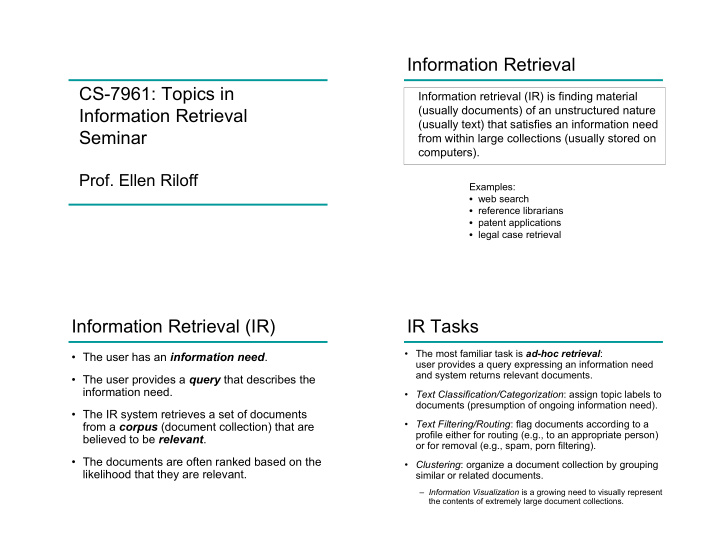



Information Retrieval CS-7961: Topics in Information retrieval (IR) is finding material (usually documents) of an unstructured nature Information Retrieval (usually text) that satisfies an information need Seminar from within large collections (usually stored on computers). Prof. Ellen Riloff Examples: • web search • reference librarians • patent applications • legal case retrieval Information Retrieval (IR) IR Tasks • The most familiar task is ad-hoc retrieval : • The user has an information need . user provides a query expressing an information need and system returns relevant documents. • The user provides a query that describes the information need. • Text Classification/Categorization : assign topic labels to documents (presumption of ongoing information need). • The IR system retrieves a set of documents • Text Filtering/Routing : flag documents according to a from a corpus (document collection) that are profile either for routing (e.g., to an appropriate person) believed to be relevant . or for removal (e.g., spam, porn filtering). • The documents are often ranked based on the • Clustering : organize a document collection by grouping likelihood that they are relevant. similar or related documents. – Information Visualization is a growing need to visually represent the contents of extremely large document collections.
Types of Documents Semi-Structured Text Examples Laura Petitte • Unstructured: natural language text Seminar Department of Psychology Announcement McGill University – There is linguistic structure, but little (if any) surface-level document structure. Thursday, May 4, 1995 12:00 pm • Semi-structured: some natural language text, but also Baker Hall 355 some surface-level document structure. Name: Dr. Jeffrey D. Hermes Affiliation: Department of AutoImmune Diseases – Examples: resumes, seminar announcements Research & Biophysical Chemistry, Merck Research Laboratories Title: “MHC Class II: A Target for Specific • Structured: data whose meaning is derived from the way Immunomodulation of the Immune Response” it is organized Host/e-mail: Robert Murphy, murph@a.crf.cmu.edu Date: Wednesday, May 3, 1995 – Databases are a common form of structured data. Time: 3:30 p.m. Place: Mellon Institute Conference Room Boolean Keyword Systems Major Issues in IR • The user provides a list of keywords that are • Polysemy : many words have multiple meanings. likely to appear in relevant documents. • Synonymy : many words can mean the same – Example: to find documents about conspiracy thing. theories involving the assassination of JFK, the user might list: JFK, conspiracy, assassination • Size/Speed : IR systems must process huge volumes of text, with instantaneous response • By default, most systems use a Boolean and time. operator, but advanced search options usually support additional Boolean operators. • Broad Coverage : IR systems must be able to handle queries about any topic whatsoever. – Example: (AND (OR(JFK,Kennedy), conspiracy, (OR(assassination,murder,shooting)))
Basic Evaluation Measures Inverted Index • Precision = percentage of returned documents • Most IR systems use an inverted index that are truly relevant. (inverted file) to represent the documents in the collection. – Intuition: hit rate. How often is the system correct? • Each document is tokenized to identify • Recall = percentage of all relevant documents indivudal terms (normalized tokens). that the system finds. • A dictionary is created from the terms, and – Intuition: coverage. How much of the desired each term is linked to a list of documents that material is found? contain the term ( postings ). Inverted Index Example Stop Words • Most IR systems use a stop list (stop words) , Assassination d1, d5, d21, d73, d304, d511… which typically consist of closed class words Conspiracy d3, d4, d7, d54, d73, d288… that do not contain much semantic information. JFK d2, d21, d50, d73, d183, d288… Kennedy d2, d5, d66, d89, d214, d288… • Stop words are not included in the inverted index, which dramatically reduces its size. The inverted index may also contain: Typical stop words: • frequency count of each term Articles: a, an, the • positional information Prepositions: of, to, from, by, with, for, at, in… Modals: would, could, should, can, will, must… etc.
Disadvantages of Stop Words Stemming • Common strings can be used in uncommon ways. • Many IR systems use stemming to match query terms with morphological variants in the documents. – Example: "the" can be a Vietnamese name – Example: • Stop words can be crucial parts of a lexicalized phrase, • assassinate title, or quote. • assassinated – Example : "to be or not to be" • assassinates • Some stopwords, such as prepositions, can provide important information about relationships. • assassinating • assassination • Disk space is much cheaper than it used to be, so saving space may not be as important as it once was. • assassinations Problems observed with the IR is not just web search! Porter Stemmer Incorrect Conflation Errors of Omission • There are some very important real-world challenges! For example: organization organ European Europe doing doe analysis analyze —Legal Search. Some real Westlaw information needs: generalization generic matrices matrix Information on the legal theories involved in preventing the numerical numerous noise noisy disclosure of trade secrets by employees formerly employed by a competing company. policy police sparse sparsity Cases about the host's responsibility for drunk guests. university universe explain explanation easy easily resolve resolution —Question Answering. NLP meets IR: most people really want computers to be able to return a specific answer to a question, addition additive triangle triangular not a set of documents. negligible negligent urgency urgent —Current IR systems do reasonably well with precision (for simple execute executive cylinder cylindrical queries), but recall is still a major problem!
Recommend
More recommend